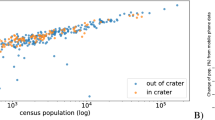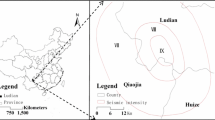Abstract
Large scale natural disasters involve budgetary problems for governments even when local and foreign humanitarian aid is available. Prioritizing investment requires near real time information about the impact of the hazard in different locations. However, such information is not available through sensors or other devices specially in developing countries that do not have such infrastructure. A rich source of information is the data resulting from mobile phones activity that citizens in affected areas start using as soon as it becomes available post-disaster. In this work, we exploit such source of information to conduct different analyses in order to infer the affected zones in the Ecuadorian province of Manabí, after the 2016 earthquake, with epicenter in the same province. We propose a series of features to characterize a geographic area, as granular as a canton, after a natural disaster and label its level of damage using mobile phone data. Our methods result in a classifier based on the K-Nearest Neighbors algorithm to detect affected zones with a 75% of accuracy. We compared our results with official data published two months after the disaster.
Access this chapter
Tax calculation will be finalised at checkout
Purchases are for personal use only
Similar content being viewed by others
References
Andrade, X., Layedra, F., Vaca, C., Cruz, E.: RiSC: quantifying change after natural disasters to estimate infrastructure damage with mobile phone data. In: 2018 IEEE International Conference on Big Data (Big Data), pp. 3383–3391. IEEE (2018)
Ashktorab, Z., Brown, C., Nandi, M., Culotta, A.: Tweedr: mining twitter to inform disaster response. In: ISCRAM (2014)
CDB: CDB, World Bank partner to increase disaster resilience through improved procurement (2018). https://www.caribank.org/newsroom/news-and-events/cdb-world-bank-partner-increase-disaster-resilience-through-improved-procurement
The World Bank: Disaster risk management (2019). https://www.worldbank.org/en/topic/disasterriskmanagement/overview
Cardona, O.D., Ordaz, M.G., Marulanda, M.C., Barbat, A.H.: Estimation of probabilistic seismic losses and the public economic resilience—an approach for a macroeconomic impact evaluation. J. Earthq. Eng. 12(S2), 60–70 (2008)
Castillo, G., Layedra, F., Guaranda, M.B., Lara, P., Vaca, C.: The silence of the cantons: estimating villages socioeconomic status through mobile phones data. In: 2018 International Conference on eDemocracy & eGovernment (ICEDEG), pp. 172–178. IEEE (2018)
Cerutti, V., Fuchs, G., Andrienko, G., Andrienko, N., Ostermann, F.: Identification of disaster-affected areas using exploratory visual analysis of georeferenced tweets: application to a flood event. Association of Geographic Information Laboratories in Europe, Helsinki, Finland, p. 5 (2016)
Cresci, S., Cimino, A., Dell’Orletta, F., Tesconi, M.: Crisis mapping during natural disasters via text analysis of social media messages. In: Wang, J., et al. (eds.) WISE 2015. LNCS, vol. 9419, pp. 250–258. Springer, Cham (2015). https://doi.org/10.1007/978-3-319-26187-4_21
De Albuquerque, J.P., Herfort, B., Brenning, A., Zipf, A.: A geographic approach for combining social media and authoritative data towards identifying useful information for disaster management. Int. J. Geogr. Inf. Sci. 29(4), 667–689 (2015)
Fernandez Galarreta, J., Kerle, N., Gerke, M.: UAV-based urban structural damage assessment using object-based image analysis and semantic reasoning. Nat. Hazards Earth Syst. Sci. 15(6), 1087–1101 (2015)
Ghosh, S., et al.: Crowdsourcing for rapid damage assessment: the global earth observation catastrophe assessment network (GEO-CAN). Earthq. Spectra 27(S1), S179–S198 (2011)
Gil, H.A.P.: Efectos del sismo del 16 de abril de 2016 en el sector productivo agropecuario de manabí. La Técnica (17), 30–42 (2017)
Giugale, M.: Time to insure developing countries against natural disasters (2017). https://www.worldbank.org/en/news/opinion/2017/10/11/time-to-insure-developing-countries-against-natural-disasters
Grünthal, G.: European macroseismic scale 1998. Technical report, European Seismological Commission (ESC) (1998)
Guha-Sapir, D., Hargitt, D., Hoyois, P.: Thirty years of natural disasters 1974–2003: the numbers. Presses univ. de Louvain (2004)
Hoeppe, P.: Trends in weather related disasters-consequences for insurers and society. Weather Clim. Extremes 11, 70–79 (2016)
Kellenberg, D., Mobarak, A.M.: The economics of natural disasters. Annu. Rev. Resour. Econ. 3(1), 297–312 (2011)
Kryvasheyeu, Y., et al.: Rapid assessment of disaster damage using social media activity. Sci. Adv. 2(3), e1500779 (2016)
MacEachren, A.M., et al.: SensePlace2: GeoTwitter analytics support for situational awareness. In: 2011 IEEE Conference on Visual Analytics Science and Technology (VAST), pp. 181–190. IEEE (2011)
Olen, S., Bookhagen, B.: Mapping damage-affected areas after natural hazard events using sentinel-1 coherence time series. Remote Sens. 10(8), 1272 (2018)
Oliveira, S., Zêzere, J.L., Queirós, M., Pereira, J.M.: Assessing the social context of wildfire-affected areas. The case of mainland Portugal. Appl. Geogr. 88, 104–117 (2017)
Pastor-Escuredo, D., Torres, Y., Martinez, M., Zufiria, P.J.: Floods impact dynamics quantified from big data sources. arXiv preprint arXiv:1804.09129 (2018)
Ranganathan, P., Pramesh, C., Aggarwal, R.: Common pitfalls in statistical analysis: logistic regression. Perspect. Clin. Res. 8(3), 148 (2017)
Rosser, J.F., Leibovici, D.G., Jackson, M.J.: Rapid flood inundation mapping using social media, remote sensing and topographic data. Nat. Hazards 87(1), 103–120 (2017). https://doi.org/10.1007/s11069-017-2755-0
Schlein, L.: UN: most deaths from natural disasters occur in poor countries (2016). https://www.voanews.com/a/un-says-most-deaths-from-natural-disasters-occur-in-poor-countries/3548871.html
Wilson, R., et al.: Rapid and near real-time assessments of population displacement using mobile phone data following disasters: the 2015 Nepal eEarthquake. PLoS Curr. 8 (2016)
Yabe, T., Sekimoto, Y., Sudo, A., Tsubouchi, K.: Predicting delay of commuting activities following frequently occurring disasters using location data from smartphones. J. Disaster Res. 12(2), 287–295 (2017)
Yu, M., Yang, C., Li, Y.: Big data in natural disaster management: a review. Geosciences 8(5), 165 (2018)
Yuan, F., Liu, R.: Feasibility study of using crowdsourcing to identify critical affected areas for rapid damage assessment: Hurricane Matthew case study. Int. J. Disaster Risk Reduction 28, 758–767 (2018)
Author information
Authors and Affiliations
Corresponding author
Editor information
Editors and Affiliations
Rights and permissions
Copyright information
© 2020 Springer Nature Switzerland AG
About this paper
Cite this paper
Castillo-López, G., Guaranda, MB., Layedra, F., Vaca, C. (2020). A Place to Go: Locating Damaged Regions After Natural Disasters Through Mobile Phone Data. In: Lossio-Ventura, J.A., Condori-Fernandez, N., Valverde-Rebaza, J.C. (eds) Information Management and Big Data. SIMBig 2019. Communications in Computer and Information Science, vol 1070. Springer, Cham. https://doi.org/10.1007/978-3-030-46140-9_23
Download citation
DOI: https://doi.org/10.1007/978-3-030-46140-9_23
Published:
Publisher Name: Springer, Cham
Print ISBN: 978-3-030-46139-3
Online ISBN: 978-3-030-46140-9
eBook Packages: Computer ScienceComputer Science (R0)




